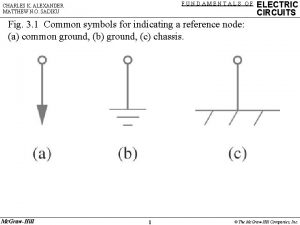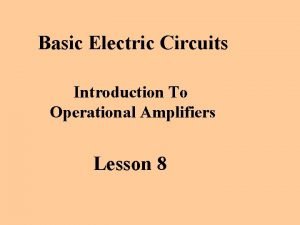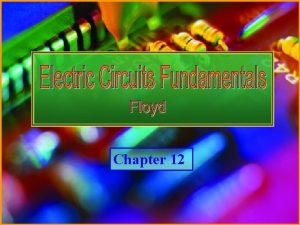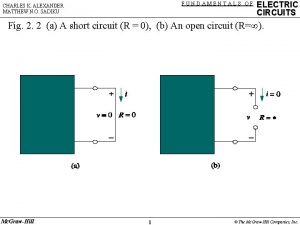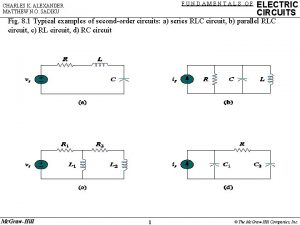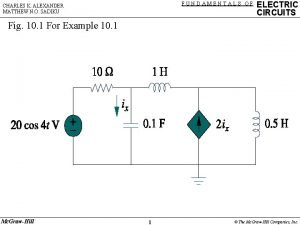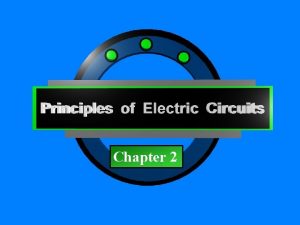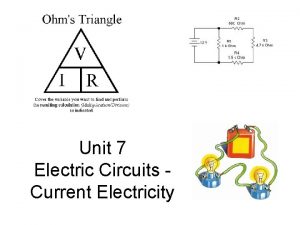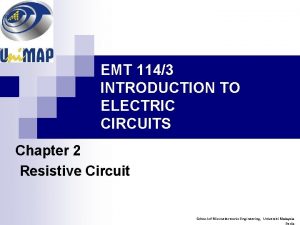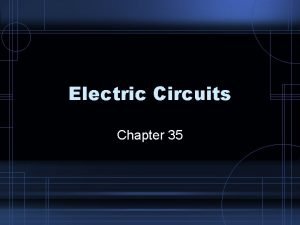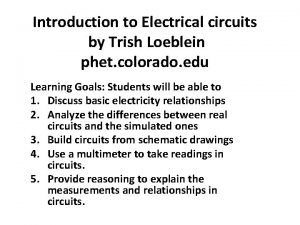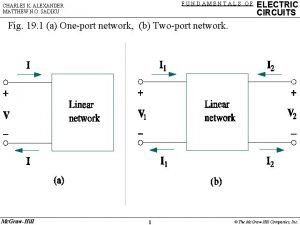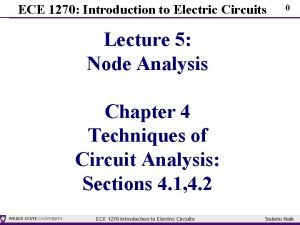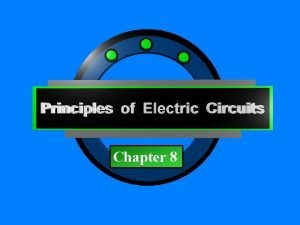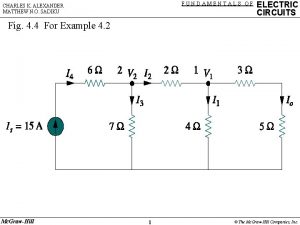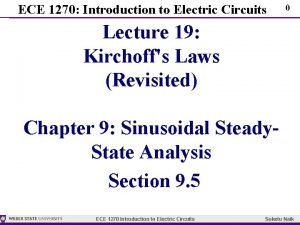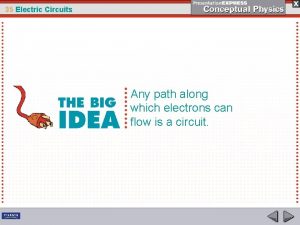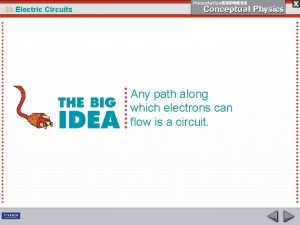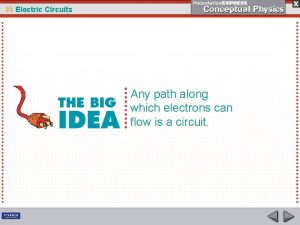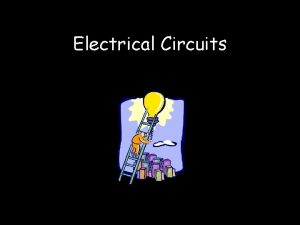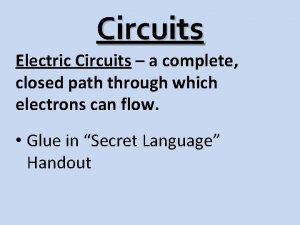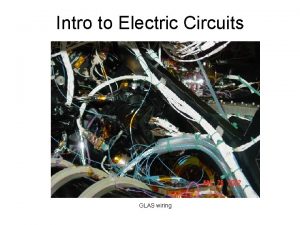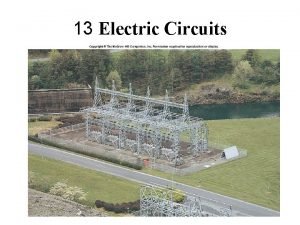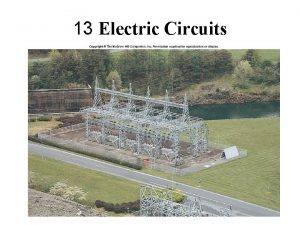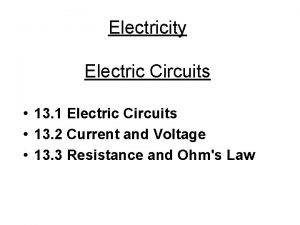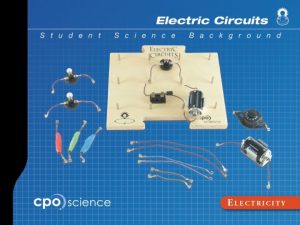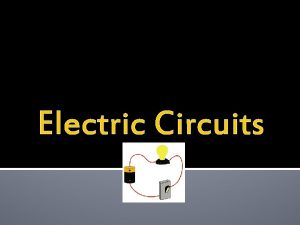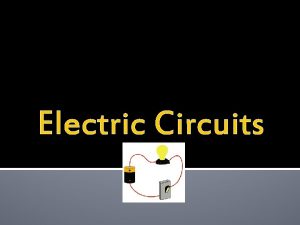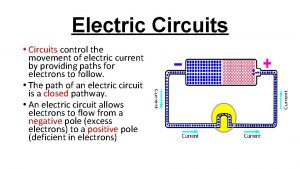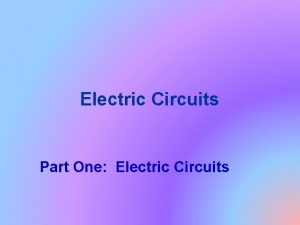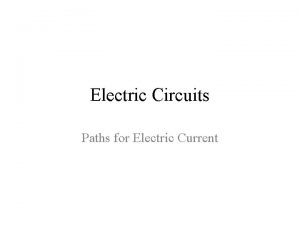35 Electric Circuits 35 Electric Circuits Any path











































- Slides: 43

35 Electric Circuits

35 Electric Circuits Any path along which electrons can flow is a circuit.

35 Electric Circuits 35. 1 A Battery and a Bulb a. Unsuccessful ways to light a bulb. b. Successful ways to light a bulb.

35 Electric Circuits 35. 1 A Battery and a Bulb Electrons do not pile up inside a bulb, but instead flow through its filament. For a continuous flow of electrons, there must be a complete circuit with no gaps.

35 Electric Circuits 35. 2 Electric Circuits Most circuits have more than one device that receives electrical energy. These devices are commonly connected in a circuit in one of two ways, series or parallel. • When connected in series, the devices in a circuit form a single pathway for electron flow. • When connected in parallel, the devices in a circuit form branches, each of which is a separate path for electron flow.

35 Electric Circuits 35. 3 Series Circuits In this simple series circuit, a 9 -volt battery provides 3 volts across each lamp.

35 Electric Circuits 35. 3 Series Circuits "1. The same current flows through each part of a series circuit. " In a series circuit, the amperage at any point in the circuit is the same. This will help in calculating circuit values using Ohm's Law. You will notice from the diagram that 1 amp continually flows through the circuit. We will get to the calculations in a moment.

35 Electric Circuits "2. The total resistance of a series circuit is equal to the sum of individual resistances. " In a series circuit you will need to calculate the total resistance of the circuit in order to figure out the amperage. This is done by adding up the individual values of each component in series. In this example we have three resistors. To calculate the total resistance we use the formula: • RT = R 1 + R 2 + R 3 …. • 2 + 3 = 7 Ohms • R total is 7 Ohms

35 Electric Circuits • Now with these two rules we can learn how to calculate the amperage of a circuit. Remember from Ohms Law that I = V / R.

35 Electric Circuits • "Voltage Drops" • Before we go any further let's define what a "voltage drop" is. A voltage drop is the amount the voltage lowers when crossing a component from the negative side to the positive side in a series circuit. If you placed a multimeter across a resistor, the voltage drop would be the amount of voltage you are reading. This is pictured with the red arrow in the diagram.

35 Electric Circuits • "3. Voltage applied to a series circuit is equal to the sum of the individual voltage drops. " • This simply means that the voltage drops have to add up to the voltage coming from the battey or batteries. • V total = V 1 + V 2 + V 3. . . • In our example above, this means that • 6 V + 6 V = 12 V. • "4. The voltage drop across a resistor in a series circuit is directly proportional to the size of the resistor. " • This is what we described in the Voltage Drop section above. • Voltage drop = Current x Resistor size.

35 Electric Circuits • "5. If the circuit is broken at any point, no current will flow. " • The best way to illustrate this is with a string of light bulbs. If one is burnt out, the whole thing stops working.

35 Electric Circuits 35. 3 Series Circuits think! What happens to the light intensity of each lamp in a series circuit when more lamps are added to the circuit?

35 Electric Circuits 35. 3 Series Circuits think! What happens to the light intensity of each lamp in a series circuit when more lamps are added to the circuit? Answer: The addition of more lamps results in a greater circuit resistance. This decreases the current in the circuit (and in each lamp), which causes dimming of the lamps.

35 Electric Circuits 35. 3 Series Circuits think! A series circuit has three bulbs. If the current through one of the bulbs is 1 A, can you tell what the current is through each of the other two bulbs? If the voltage across bulb 1 is 2 V, and across bulb 2 is 4 V, what is the voltage across bulb 3?

35 Electric Circuits 35. 3 Series Circuits think! A series circuit has three bulbs. If the current through one of the bulbs is 1 A, can you tell what the current is through each of the other two bulbs? If the voltage across bulb 1 is 2 V, and across bulb 2 is 4 V, what is the voltage across bulb 3? Answer: The same current, 1 A, passes through every part of a series circuit. Each coulomb of charge has 9 J of electrical potential energy (9 V = 9 J/C). If it spends 2 J in one bulb and 4 in another, it must spend 3 J in the last bulb. 3 J/C = 3 V

35 Electric Circuits 35. 4 Parallel Circuits In this parallel circuit, a 9 -volt battery provides 9 volts across each activated lamp. (Note the open switch in the lower branch. )

35 Electric Circuits 35. 4 Parallel Circuits 1. "A parallel circuit has two or more paths for current to flow through. " Simply remember that PARALLEL means two paths up to thousands of paths. The flow of electricity is divided between each according to the resistance along each route.

35 Electric Circuits • 2. "Voltage is the same across each component of the parallel circuit. " • You may remember from the last section that the voltage drops across a resistor in series. Not so with a parallel circuit. The voltage will be the same anywhere in the circuit.

35 Electric Circuits • 3. "The sum of the currents through each path is equal to the total current that flows from the source. " • If one path is drawing 1 amp and the other is drawing 1 amp then the total is 2 amps at the source. If there are 4 branches in this same 2 amp circuit, then one path may draw 1/4 A (. 25 A), the next 1/4 A (. 25), the next 1/2 A (. 5 A) and the last 1 A.

35 Electric Circuits • 4. "You can find TOTAL RESISTANCE in a Parallel circuit with the following formula: 1/Rt = 1/R 1 + 1/R 2 + 1/R 3 +. . . " • Before we get into the calculations, remember what we said at the start of this section: "The total resistance of a parallel circuit is NOT equal to the sum of the resistors (like in a series circuit).

35 Electric Circuits • 5. "If one of the parallel paths is broken, current will continue to flow in all the other paths. " • The best way to illustrate this is also with a string of light bulbs in paralallel. If one is burnt out, the others stay lit.

35 Electric Circuits 35. 4 Parallel Circuits think! What happens to the light intensity of each lamp in a parallel circuit when more lamps are added in parallel to the circuit?

35 Electric Circuits 35. 4 Parallel Circuits think! What happens to the light intensity of each lamp in a parallel circuit when more lamps are added in parallel to the circuit? Answer: The light intensity for each lamp is unchanged as other lamps are introduced (or removed). Although changes of resistance and current occur for the circuit as a whole, no changes occur in any individual branch in the circuit.

35 Electric Circuits 35. 5 Schematic Diagrams Electric circuits are frequently described by simple diagrams, called schematic diagrams. • Resistance is shown by a zigzag line, and ideal resistance -free wires are shown with solid straight lines. • A battery is shown by a set of short and long parallel lines, the positive terminal with a long line and the negative terminal with a short line.

35 Electric Circuits 35. 5 Schematic Diagrams These schematic diagrams represent a. a circuit with three lamps in series, and b. a circuit with three lamps in parallel.

35 Electric Circuits 35. 7 Parallel Circuits and Overloading Consider a line connected to a toaster that draws 8 amps, a heater that draws 10 amps, and a lamp that draws 2 amps. • If the toaster is operating, the total line current is 8 amperes. • When the heater is also operating, the total line current increases to 18 amperes. • If you turn on the lamp, the line current increases to 20 amperes.

35 Electric Circuits 35. 7 Parallel Circuits and Overloading To prevent overloading in circuits, fuses or circuit breakers are connected in series along the supply line. The entire line current must pass through the fuse. If the fuse is rated at 20 amperes, it will pass up to 20 amperes. A current above 20 amperes will melt the fuse ribbon, which “blows out” and breaks the circuit.

35 Electric Circuits 35. 7 Parallel Circuits and Overloading Before a blown fuse is replaced, the cause of overloading should be determined and remedied. Insulation that separates the wires in a circuit can wear away and allow the wires to touch. This effectively shortens the path of the circuit, and is called a short circuit. A short circuit draws a dangerously large current because it bypasses the normal circuit resistance.

35 Electric Circuits Assessment Questions 1. In a light bulb, the amount of current in the filament is a. slightly less than the current in the connecting wires. b. the same as the current in the connecting wires. c. slightly greater than the current in the connecting wires. d. twice as great as the current that is in the connecting wires.

35 Electric Circuits Assessment Questions 1. In a light bulb, the amount of current in the filament is a. slightly less than the current in the connecting wires. b. the same as the current in the connecting wires. c. slightly greater than the current in the connecting wires. d. twice as great as the current that is in the connecting wires. Answer: B

35 Electric Circuits Assessment Questions 2. The flow of charge in an electric circuit is a. much like the flow of water in a system of pipes. b. very different from water flow in pipes. c. like an electric valve. d. like an electric pump.

35 Electric Circuits Assessment Questions 2. The flow of charge in an electric circuit is a. much like the flow of water in a system of pipes. b. very different from water flow in pipes. c. like an electric valve. d. like an electric pump. Answer: A

35 Electric Circuits Assessment Questions 3. In a series circuit, if the current in one lamp is 2 amperes, the current in the battery is a. half, 1 A. b. 2 A. c. not necessarily 2 A, depending on internal battery resistance. d. more than 2 A.

35 Electric Circuits Assessment Questions 3. In a series circuit, if the current in one lamp is 2 amperes, the current in the battery is a. half, 1 A. b. 2 A. c. not necessarily 2 A, depending on internal battery resistance. d. more than 2 A. Answer: B

35 Electric Circuits Assessment Questions 4. In a circuit with two lamps in parallel, if the current in one lamp is 2 amperes, the current in the battery is a. half, 1 A. b. 2 A. c. more than 2 A. d. cannot be calculated from the information given

35 Electric Circuits Assessment Questions 4. In a circuit with two lamps in parallel, if the current in one lamp is 2 amperes, the current in the battery is a. half, 1 A. b. 2 A. c. more than 2 A. d. cannot be calculated from the information given Answer: C

35 Electric Circuits Assessment Questions 5. In a circuit diagram there may be a. no switches. b. at most, one switch. c. two switches. d. any number of switches.

35 Electric Circuits Assessment Questions 5. In a circuit diagram there may be a. no switches. b. at most, one switch. c. two switches. d. any number of switches. Answer: D

35 Electric Circuits Assessment Questions 6. Consider a compound circuit consisting of a pair of 6 -ohm resistors in parallel, which are in series with two 6 -ohm resistors in series. The equivalent resistance of the circuit is a. 9 ohms. b. 12 ohms. c. 15 ohms. d. 24 ohms.

35 Electric Circuits Assessment Questions 6. Consider a compound circuit consisting of a pair of 6 -ohm resistors in parallel, which are in series with two 6 -ohm resistors in series. The equivalent resistance of the circuit is a. 9 ohms. b. 12 ohms. c. 15 ohms. d. 24 ohms. Answer: C

35 Electric Circuits Assessment Questions 7. One way to prevent overloading in your home circuit is to a. operate fewer devices at the same time. b. change the wiring from parallel to series for troublesome devices. c. find a way to bypass the fuse. d. find a way to bypass the circuit breaker.

35 Electric Circuits Assessment Questions 7. One way to prevent overloading in your home circuit is to a. operate fewer devices at the same time. b. change the wiring from parallel to series for troublesome devices. c. find a way to bypass the fuse. d. find a way to bypass the circuit breaker. Answer: A
 Advantages of parallel circuits over series circuits
Advantages of parallel circuits over series circuits A connected graph tree without any cycle is also called?
A connected graph tree without any cycle is also called? Unity signalr
Unity signalr Any to any connectivity
Any to any connectivity Seknder
Seknder There isn't any chicken
There isn't any chicken Fundamentals of electric circuits
Fundamentals of electric circuits Worksheet circuits and ohm's law answer key
Worksheet circuits and ohm's law answer key Electric circuits equations
Electric circuits equations Electric circuits fundamentals floyd
Electric circuits fundamentals floyd Fundamentals of electric
Fundamentals of electric Sadiku
Sadiku Electric current
Electric current Quarturs
Quarturs Fundamentals of electric circuits
Fundamentals of electric circuits The circuit chapter 9
The circuit chapter 9 Principle of electric circuit
Principle of electric circuit Physics reference table
Physics reference table Introduction to electric circuits
Introduction to electric circuits Elec 202
Elec 202 Conceptual physics chapter 35 electric circuits
Conceptual physics chapter 35 electric circuits Basic electrical engineering kulshreshtha
Basic electrical engineering kulshreshtha Chapter 35 electric circuits
Chapter 35 electric circuits Fundamentals of electric circuits chapter 7 solutions
Fundamentals of electric circuits chapter 7 solutions Three elements of a basic program for electrical safety are
Three elements of a basic program for electrical safety are Phet electric circuit
Phet electric circuit Alexander
Alexander Find vx
Find vx Electric circuits grade 6
Electric circuits grade 6 James w nilsson
James w nilsson Chapter 20 electric circuits
Chapter 20 electric circuits The circuit chapter 8 summary
The circuit chapter 8 summary Sadiku
Sadiku Chapter 35 electric circuits answers
Chapter 35 electric circuits answers Fundamentals of electric circuits chapter 4 solutions
Fundamentals of electric circuits chapter 4 solutions Ece
Ece A closed path that electric current follows is a(n) ______.
A closed path that electric current follows is a(n) ______. Chapter 16 electric charge and electric field
Chapter 16 electric charge and electric field Electric potential and electric field
Electric potential and electric field A suitable electric pump in an electric circuit is a
A suitable electric pump in an electric circuit is a Electric potential due to dipole
Electric potential due to dipole Chapter 21 electric charge and electric field
Chapter 21 electric charge and electric field Dc o/d per item charge
Dc o/d per item charge Electric potential
Electric potential






